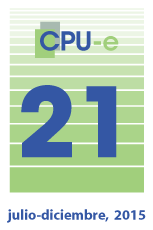Resumen
Este trabajo identifica y caracteriza algunas concepciones de alumnos de bachillerato sobre las propiedades del comentario escrito de un texto narrativo en un ambiente académico, y algunas maneras en que aplican esos criterios para redactar y corregir sus textos. El enfoque corresponde al estudio de la intencionalidad en el desempeño en el marco de los estudios de la textualidad. Los ejemplos representativos de los textos nos permiten apreciar las concepciones sobre el comentario escrito de una lectura narrativa y, en la práctica, la intencionalidad en las decisiones para escribir y editar los textos. Se presenta el diseño metodológico de elicitación para que los estudiantes escribieran comentarios, el procedimiento de caracterización y clasificación de los textos y las categorías propuestas para estudiar los textos en términos del tipo de información, los tipos de texto y los recursos discursivos.
Abstract
This paper identifies and characterizes some conceptions of high school students about the properties of written comments of narrative texts in academic environment, and some ways they apply those criteria to compose and edit their texts. The research corresponds to an approach of intentionality in performance in textual studies. Representative examples of the texts let us appreciate the conceptions about the written comment of a narrative text and, in practice, the intentionality in the decisions involved in writing and editing texts. The paper presents the elicitation methodology to have students write their comments, the textual characterization and classification procedures and the study categories in terms of the type of text, discursive resources and information in the texts.
Recibido: 28 de septiembre de 2014
Aceptado: 09 de marzo de 2015
Citas
Adam, J. M. (2004). Linguistique textuelle. Des genres de discours aux textes. Une introduction méthodique á l´analyse textuelle des discourse. Paris: Nathan.
Bailey, N., Madden, C., & Krashen, S. D. (december, 1974). Is there a “natural sequence” in adult second language learning? Language Learning, 24, 235-243.
Bajtín, M. (1982). Estética de la creación verbal. México: Siglo XXI.
Beuchot, M. (2002). Perfiles esenciales de la hermenéutica. México: Universidad Nacional Autónoma de México.
Beugrande, R., & Dressler, W. (1997). Introducción a la lingüística del texto. Barcelona: Ariel.
Brice, S. (1983). Ways with words. Language, life and work in communities and classrooms. Nueva York: Cambridge Universtiy Press.
Brice, S., & Street, B. (2008). Ethnography. Approaches to language and literacy research. Nueva York: Teachers College Press.
Camps, A. (1992). Algunas observaciones sobre la capacidad de revisión de los adolescentes. Infancia y aprendizaje, 58, 65-81.
Camps, D. (2009). Advanced EFL student´s revision practices through their writing process. En A. Cater, T. Lillis & S. Parkin (Eds.), Why writing matters: Issues of access and identity in writing research and pedagogy (pp. 129-149). United States of America: John Benjamins Publishing Company.
Cassany, D. (2002). Reparar la escritura. Didáctica de la corrección de lo escrito. Barcelona: Graó.
Cassany, D. (2006). Taller de textos: leer, escribir y comentar en el aula. Barcelona: Paidós.
Cassany, D., Luna, M., & Sanz, G. (2002). Enseñar Lengua. Barcelona: Graó.
Dulay, H. C., & Burt. M. K. (1974). Errors and strategies in child second language acquisition. TESOL Quarterly, 8, 129-136.
Flower, L., & Hayes, J. R. (december, 1981). A cognitive process theory of writing. College composition and communication, 32, 365-387.
Gass, S. M., & Mackey, A. (2007). Data elicitation for second and foreign language research. New Jersey: Lawrence Erlbaum Associates.
Graves, D. H. (2002). Didáctica de la escritura. Madrid: Morata/Ministerio de Educación, Cultura y Deporte.
Hyland, K. (2005). Metadiscourse: exploring interaction in writing. London: Continuum.
Ivanič, R. (1988). Writing and identity: The discoursal construction of identity in academic writing. United States of America: John Benjamins Publishing Company.
Johnson, D. (1992). Approaches to research in second language learning. London: Longman.
Lázaro, F., & Correa, E. (2008). Cómo se comenta un texto literario. Madrid: Cátedra.
Lea, M., & Street, B.V. (1998). Student writing in higher education. An academic literacies approach. Studies in higher education, 23(2), 157-172.
Nunan, D. (1990). Action research in the language classroom. En J. C. Richards & D. Nunan (Eds.), Second language teacher education (pp. 62-81). United Kingdom: Cambridge University Press.
Pacheco, J. E. (1981). Las Batallas en el desierto. México: ERA.
Paredes, M. (2007). Teorías de la intencionalidad. Madrid: Síntesis.
Puig, L. (Ed.). (2009). El discurso y sus espejos. México: Universidad Nacional Autónoma de México.
Saint-Exúpery de, A. (1998). El principito. México: Latinoamericana.
Sinclair, J. M., & Brazil, D. (1982). Teacher talk. London: Oxford University Press.
Turner, J. (2011). Language in the academy. cultural and intercultural dynamics. England: British Library Cataloguing in Publishing Data.
Van Dijk, T. A. (1983). La ciencia del texto. México: Paidós.
Wajnryb, R. (1992). Classroom observation tasks. United Kingdom: Cambridge University Press.
Wenden, A. (1986). Helping language learners think about learning. ELT Journal. An international journal for teachers of English to speakers of other languages, 40(1), 161-175.
Los autores son los legítimos titulares de los derechos de propiedad intelectual de sus respectivos artículos, y en tal calidad, al enviar sus textos expresan su deseo de colaborar con CPU-e, Revista de Investigación Educativa, editada por el Instituto de Investigaciones en Educación de la Universidad Veracruzana.
Por lo anterior, de manera libre, voluntaria y a título gratuito, una vez aceptado el artículo para su publicación, ceden sus derechos a la Universidad Veracruzana para que el Instituto de Investigaciones en Educación reproduzca, edite, publique, distribuya y ponga a disposición dicha obra a través de intranets, internet o dispositivos de almacenaje, sin limitación alguna de forma o tiempo, siempre y cuando sea sin fines de lucro y con la obligación expresa de respetar y mencionar el crédito que corresponde a los autores en cualquier utilización que se haga del mismo.
Queda entendido que esta autorización no es una cesión o transmisión de alguno de sus derechos patrimoniales en favor de la mencionada institución, ni tampoco una licencia exclusiva, pues sólo tendrá una vigencia de seis meses a partir de la fecha de publicación.

CPU-e, Revista de investigación Educativa,
así como todos sus contenidos están bajo una
Licencia Creative Commons
Atribución-NoComercial 4.0 Internacional.

